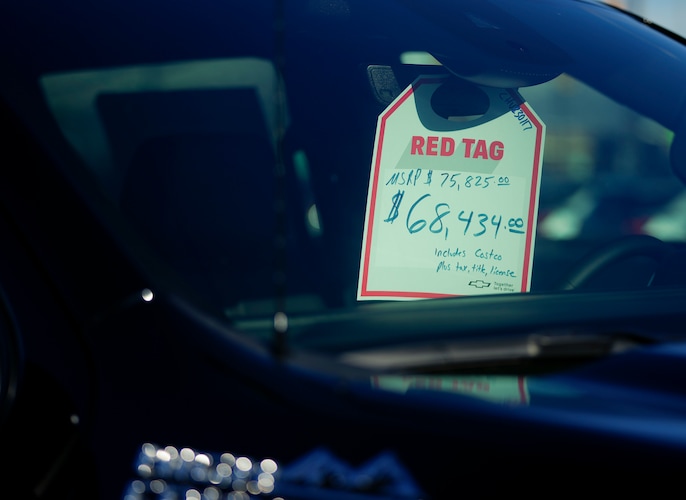When buying a house seems out of reach, how are you going to show you’re moving up in the world?
How about a $70,000 ride?
Car buyers in Utah are feeling the pinch as the cost of financing has taken a jump this year. After years of car loan rates under 5%, the average rate is now closer to 8%, and the average new car payment in the U.S. is above $700.
In spite of that, sales are up in Utah this year. Through September, Utahns have bought 107,974 new cars and “light trucks.” (Light trucks include SUVs and pickup trucks.) That is a 12.2% jump on the 96,209 new vehicles sold through September of last year.
And according to Edmunds Automotive, 22.2% of new car buyers in Utah are now signing up for car payments of more than $1,000 a month. That’s the sixth highest percentage of any state. (Neighboring Wyoming is at the top with 29.5%)
At 7.8% interest, $1,000 monthly payments for six years will cover close to a $60,000 loan, enough for a loaded new ride.

(Bethany Baker | The Salt Lake Tribune) A price tag is seen in the window of a new Chevrolet pickup truck at a dealership in Murray on Tuesday, Dec. 5, 2023. Pickup trucks commonly sell in Utah for between $60,000 and $70,000.
What’s driving the increase? The answer may lie in “status consumption,” said Jessie X. Fan, chair of the Family and Consumer Studies Department at the University of Utah.
“Cars and houses are very visible to other people,” said Fan. “They want to buy a little fancier to show their status. One hypothesis is that as housing becomes less attainable, cars become relatively more attainable as a status consumption good. As such, people are willing to borrow more for a car.”
Craig Bickmore, executive director for New Car Dealers of Utah, a trade association, thinks rising sales in the face of rising interest rates points to the importance of cars in people’s lives. “It’s just so imperative that people have transportation.”
He also believes the supply of new cars is now better than it has been since the pandemic, and there is some pent up demand finally being met. “This year we’ve had more inventory than we’ve had previously.”
(Bethany Baker | The Salt Lake Tribune) A Utah consumer behavior expert theorizes on why people are willing to spend $60,000 and more on a new truck: "As housing becomes less attainable, cars become relatively more attainable as a status consumption good. As such, people are willing to borrow more for a car.” Seen here, new Chevrolet pickups at a Murray dealership on Tuesday, Dec. 5, 2023.
(Bethany Baker | The Salt Lake Tribune) New Chevrolet pickup trucks are seen parked at a dealership in Murray on Tuesday, Dec. 5, 2023. The supply of new vehicles in Utah is up, but prices are not dropping.
The supply of new cars is up, but that doesn’t mean prices are dropping. Fan said vehicles are selling at manufacturers suggested retail price (MSRP) or above. ”Before the pandemic, that was not the case. MSRP was not the minimum.”
Advice generally runs that car payments shouldn’t be more than 15% of monthly income, but Fan says the more important number is overall debt including a mortgage. That should stay under 40% of income.
She said there are definitely some buyers who are “present oriented” and don’t think long-term about their debt. “Some people just want the car. They look at the payment and think they can afford it. ... They just want it now.”
But taking on too much debt isn’t worth the mental wear and tear, she said. “I would just say, in general, if your financial situation is causing you stress and anxiety, then cut back on consumption, including your car. You don’t have to have a car with all those bells and whistles.”
But many can safely manage a mortgage-sized car payment. “Just because it’s over $1,000, it doesn’t mean everyone is in trouble,” she said.
Fan, whose research has included studies on the declining middle class, doesn’t see much evidence that people are going without cars. “In terms of number of cars per person, I think it’s going to stay about the same.”
What are Utahns buying?
Pickup trucks are at the top of the list, according to sales data from the Utah Division of Motor Vehicles. Chevrolet Silverado is the largest selling make and model in Utah, with 6,020 of them sold through September. That is followed by the Ford F-150 (4,516), Ram 2500 (3,917) and GMC Sierra (3,284). All four have base models that start in the $36,000-$48,000 range, but with options they can reach $70,000 or more.
(Bethany Baker | The Salt Lake Tribune) If you think Utahns love their pickup trucks, data bears that out. The Chevrolet Silverado, seen on a Murray car lot on Tuesday, Dec. 5, 2023, is the largest selling truck make and model in Utah.
Collectively, those four are 16.4% of the total new vehicle purchases this year. Out of the 20 top-selling models in Utah this year, only one, the Toyota Camry, is a passenger car, and it was in 20th place. The 19 above it are all SUVs and trucks.
Editor’s note • This story is available to Salt Lake Tribune subscribers only. Thank you for supporting local journalism.







